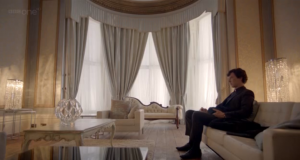

One prominent feature of “A Scandal in Belgravia” is the use of profile shots—one-sided views of characters. The use of these camera angles is particularly striking in two particular scenes: when John finds Sherlock sitting in Buckingham Palace, and when Sherlock sits alone in Irene Adler’s sitting room. With the way the scenes are set up, the viewer can almost imagine a mirror placed in between the two photos, with Sherlock reflected in each of them. He even appears to be staring at himself across the different shots.
In both the Buckingham Palace scene and the sitting room scene, Sherlock sits slightly off to the side and is distanced from the camera.Everything in both scenes is entirely focused, so that it looks like a painting or a photograph. The stillness of each scene also helps to convey the impression of a photo. Both rooms feature a background that fades symmetrically into the distance, drawing the viewer’s eye at first to the center of the shot rather than to Sherlock, the main character. Both rooms appear to be filled with light and light colors, except for a few jarringly dark anomalies. In Buckingham Palace, Sherlock’sdark suit sits on the table; in the sitting room, Sherlock is dressed in black.
In a strange way, the shots are as opposite as they are alike. In the Buckingham Palace scene, Sherlock sits on the left side of the shot, facing right, and wears a white sheet. In contrast, in the sitting room scene, Sherlock sits on the right side of the shot, facing left, and wears a black suit. His body language is also opposite: in Buckingham Palace, Sherlock maintains a very tense and protective posture, while in Irene Adler’s sitting room, he is clearly very relaxed and holds his hands and arms loosely. This body language is slightly counterintuitive, considering the fact that in Buckingham Palace, Sherlock is supposed to be among friends, while Irene Adler is a known enemy.
The two mirrored scenes emphasize the differences between Sherlock and the rest of the world. In Buckingham Palace, Sherlock Holmes is out of place and uncomfortable. This is shown by everything from the tight posture that he maintains throughout the scene to the fact that he is wearing white while everyone else is wearing black (the fact that he resisted changing into a black suit to match everyone else is significant as well). In Adler’s sitting room, Sherlock is much more in his element. His ease with his surroundings is reflected in the fact that, once Adler puts on his coat, she becomes almost a mirror image of him, highlighting an equality and kinship between the two characters that Sherlock clearly cannot experience anywhere else.
Fantastic cinematographic analysis. You really hit on the single-point perspective shots that Moffat uses a lot. You can actually see a lot of parallels between Moffat’s fimatic style and the style of Stanley Kubrick – http://www.youtube.com/watch?v=flq0t4jrqJQ
You could also mention the shot where Adler and Sherlock are sitting across from each other at the fireplace, before he takes her pulse. It doesn’t mirror another image from the film, but they are mirror images of each other.